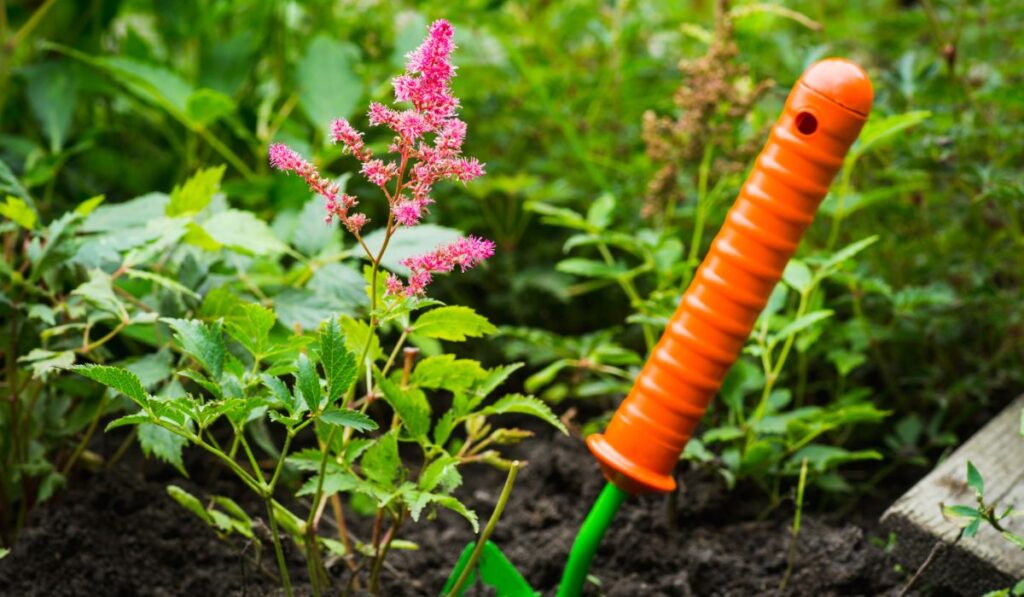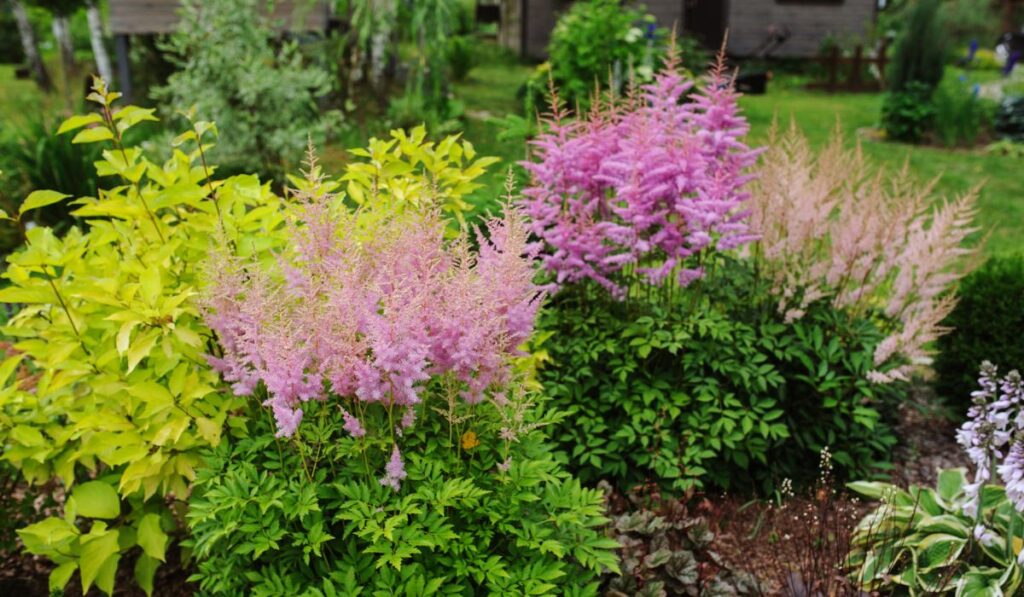Astilbe is a perennial flowering plant that blooms for up to three weeks, producing a stunning cluster of flowers. These flowers are available in different colors and add a touch of beauty to any garden. Astilbes are easy to grow for all gardeners, novice and expert alike. However, if you want the best results from your astilbe planting, you must know when to plant it.
The best time to plant astilbe is between late September and mid-October. Even though these flowering plants grow during the hot and dry months, astilbes grow best when the soil is cool and moist. So, it would be best to plant them during springtime or autumn.
Furthermore, these plants thrive in well-drained soil full of nutrients. There are other interesting things to learn about astilbes. Here, we examine everything you need to know about astilbes so they flourish in your garden.
What is Astilbe?

Astilbes (on Amazon) are among the simplest perennial flowers to grow and maintain. These flowering plants survive even in the harshest conditions. Astilbes are usually one to three feet tall, offering plume-like flowers that rise above your summer garden’s lush, green foliage.
These plume-like flower colors range from white and red to pink and lavender. Astilbes grow slowly, but once fully mature, these perennials bloom for many years. Astilbe comes in numerous varieties. Each variety has its characteristics: height, bloom time, and different colors. First, let’s look at the most common varieties of astilbes.
1. Astilbe ‘Jump and Jive’
Jump and Jive bloom from early to mid-summer and have dark pink flowers. This variety grows up to 17 inches tall with a 20-inch span. Like others, Jump and Jive develops better in rich and moist soil. This specie serves as excellent ground cover for shade gardens.
2. Astilbe Fanal
The fanal grows up to 20 inches and produces deep red flowers. This variety thrives in partial and full shade throughout the summer and prefers well-drained, nutrient-rich soil. Moreover, the vibrant color attracts pollinators. So, you can be sure to see more of these plants around your garden.
3. Astilbe Simplicifolia
Astilbe Simplicoficia reaches heights of 16 inches and widths of 13 inches. It produces light pink flowers that expand over bronze-colored foliage. The simplicifolia thrives in shady garden spots and grows best in moist soil. Simplicifolia blooms from late summer to early fall.
4. Astilbe Montgomery
Montgomery is a bright magenta-blooming variety that must be grown in partial to full shade. However, this variety will stand the mild summer heat. The Montgomery is 24 inches tall and blooms from early to mid-summer. If you want to plant this specie, remember to space them roughly 20 inches apart.
5. Chinese astilbe
Chinese astilbe is notable for its pink flowers that appear during summer. This variety prefers shady areas but withstands a few hours of direct sunlight in mild climates.
6. Chocolate Shogun
Chocolate Shogun astilbe is another variety with deep purple foliage. In late summer, this specie blooms displaying light pink flowers. It is a highly adaptable plant that prefers growing in warmer climates than other species.
You either grow it in partial shade or full sun in warmer zones, as long as it receives the necessary moisture and mulch. At maturity, this plant stands around 22 inches tall and 16 inches wide.
7. Rheinland
Rhieland is a showy, stylish perennial with pink blossoms and dark green foliage that gives it a lush appearance in shady areas. It is also an excellent plant to grow in partial and full shade.
When Should You Start Astilbe?
Start planting astilbe in the spring or fall from late September to mid-October. Because these plants tend to dry out, avoid planting in the summer. It is possible to grow astilbe from seed, but it may not be easy to germinate and might take several years to attain maturity.
Astilbe spreads quickly, so it is more effective to divide mature plants to grow new ones.
Furthermore, it is possible for faded flowerheads to self-germinate with new plants appearing near the garden in spring and summer. Another plus of this propagation process is that it leads to the most attractive varieties of astilbes.
Typically, these seedlings mature within three years.
Where Does Astilbe Grow Best?
Astilbe plants thrive in part shade, but they also thrive in full shade or full sun. Although Astilbe bloom in full shade, the plants require sunlight to reach full maturity.
Generally, astilbes dry out in high temperatures, and their foliage may burn when exposed to direct sunlight during hot summer months.
Therefore, you’ll need to provide these plants with some shade. Furthermore, astilbes grow best in rich, moist soil with a pH ranging from 6.0 to 6.5.
Watering
These glorious plants begin to require more water when the weather gets hotter. In addition, astilbe does not tolerate long drought well, resulting in dry and brown leaves. The plants die if you leave them dry for too long.
We recommend watering this plant deeply at the base during these harsh conditions every week. By doing so, you are assured that your plants will survive those extreme temperatures. Be sure to keep the soil moist but not wet.
Nutrients
Here’s another tip, place two inches of mulch around the astilbes stem after the first frost to preserve the roots. Asides from mulching, astilbes require phosphorus to bloom. So, we recommend using a 5-10-5 or 10-10-10 fertilizer. Ensure you place some fertilizer on the garden bed two weeks before planting.
Alternatively, you could sprinkle a few particles on top of the soil after planting the astilbe. It would help fertilize the plant when the soil is moist during spring. When the soil is moist, plants absorb nutrients better.
How Deep Do You Plant Astilbe?
When planting clumped-up bare-root astilbes, ensure the hole is four to seven inches deep and commutable wider than the root. Furthermore, plant astilbes with their roots facing downwards and crowns two inches below soil level. Afterward, cover the bare roots with soil and water the spot thoroughly.
For astilbes that have spent weeks growing in the nursery, make the hole ten to twelve inches deep to accommodate the deeper roots. Add some compost and ensure the point where roots and the stem meet should be slightly below ground level. Afterward, cover the hole and water the plant thoroughly.
Will Astilbe Survive Frost?
Even though astilbe is known to survive frost, cold winter temperatures may kill the plant, especially if the plant isn’t given the proper support. Therefore, you should support the plant to ensure that it displays its beautiful colors the following spring.
As you must know by now, astilbes love moist conditions. So, continue watering them until the ground freezes. After the first frost passes, apply roughly two inches of mulch around the astilbes stem.
Mulching will help regulate the soil temperature and ensure the soil stays moist throughout the winter. But, remember, do not mulch until frost arrives. Even though the roots prefer moisture, mulching in hot weather traps excess moisture, leading to root rot.
Astilbes Pests and Diseases

Most astilbe varieties are resilient to animals like deer and rabbits. However, these plants are susceptible to specific plant pests and diseases. Let’s look at three common pests & diseases and discuss how to avoid/eliminate them.
1. Powdery Mildew
Powdery mildew is a fungal disease common in hot, dry climates. Powdery mildew slows down plant growth and even kills the plant completely. Ensure you mulch when necessary to reduce the risk of powdery mildew affecting your plant.
2. Tarnished Plant Bug
This insect causes havoc on the astilbes by feeding on their flowers and buds. To eliminate this pest, use a pesticide.
3. Bacterial Lead Spots
These diseases cause spots to appear on the leaves, which lead to the growth of potentially damaging bacteria. Fortunately, gardeners can easily control this disease by spraying fungicides.
4. Wilt
Fusilarium wilt infects astilbe plant tissue. Wilt symptoms include wilted and yellow leaves that turn brown and dry up. Even if you water the plant properly, the wilt causes these drought-like symptoms. Wilt control entails removing the infected plants/leaves and replacing the soil around the astilbes.
5. Asiatic Beetles
Adult Asiatic beetles love eating astilbe is a favorite. This beetle is deep brown and usually appears during July. Afterward, the beetles lay eggs in the soil, and the larvae begin to feed on the plant’s roots. Ensure you apply pesticides early in the season to prevent these pests from damaging the plant.
Conclusion
That’s all there is to know about planting astilbes. Remember, it’s best to plant astilbes during spring or fall. Also, ensure you plant astilbes in moist soil, in a hole big enough to accommodate the bare roots.
Follow our tips to support this plant during winter and apply pesticides and fungicides when you notice anything strange with the plant.
